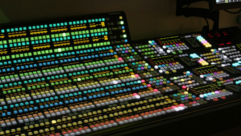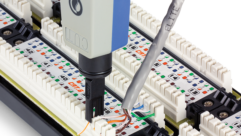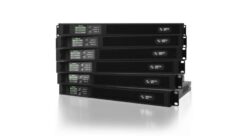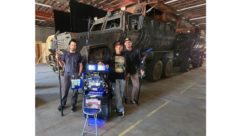ANYTHING BUT CONVENTIONAL
Sep 1, 2003 12:00 PM,
By Daniel Keller
Any major urban project is a complex undertaking — all the more so when it involves a public facility the magnitude of a 0convention center. As a huge revenue generator for many communities, convention centers tread a fine line between the aesthetic and the strategic, representing both a massive presence and an intimate focal point to a city’s downtown heartbeat.
- The expansion of the Oregon Convention Center (OCC) in Portland has been one of the most ambitious urban projects in recent history, not merely for its architectural design but for its technical and environmental achievements, as well. The 18-acre site has forged an expanded presence on the city’s famed waterfront that is at once commanding and inviting. Unlike so many massive sprawling structures that tend to dissect and fragment their neighborhoods, the newly expanded OCC site acts as a hub to draw together much of the downtown area’s recently awakening east side.
- Much attention has been paid to integrating the OCC with its environment, both in the immediate sense and globally. Nearly a quarter of the materials used in the expansion were created using recycled consumer waste products. Photo sensors dim fluorescent lighting when sunlight is abundant, and specially designed low-emissivity windows filter heat while allowing natural light to pass through. At the southwest corner of the lush green landscaped grounds, the rain garden — five interconnected pools studded with rush grasses and basalt columns — conjures the soothing flow of a rural brook while belying its purpose-built function of diverting rainwater runoff from the center’s 5½-acre roof away from the nearby Willamette River.
At a million square feet, the newly enlarged OCC is one of the biggest convention centers in the western United States. The brainchild of architectural firm Zimmer Gunsel Frasca — whose past works include Seattle’s Millennium Tower, Portland’s streetcar and MAX light-rail systems, and Microsoft’s Redmond, Washington, campus — the $116 million expansion project was undertaken nearly 13 years ago. But though the OCC boasts some remarkable ecological and design achievements, its technological accomplishments are what place it in a class of its own.
THE BETTER TO HEAR YOU WITH
Audio and visual design is hardly an afterthought in a communication-dependent environment like a convention center, but many times it’s an overlooked and underappreciated component. Besides lacking the awe-inspiring appeal of majestic towers, sweeping glass promenades, and larger-than-life works of art, the audiovisual system is frequently designed to blend in and not make a splash in and of itself. It is, after all, the messenger and not the message.
But the sophistication of the OCC’s A/V component is particularly noteworthy in that it incorporates technologies that, when construction began, barely existed beyond white paper and theory. Michael Shafer, principal of the audiovisual group of Seattle-based Sparling Electrical and Technology Consultants, explains: “We wanted to create a system with enough flexibility to support most projects in-house without bringing in a lot of extra gear and to integrate well with any gear that is brought in,” he says. “When we began the project two or three years ago, CobraNet technology was not really refined yet. But the designers’ plans gave us a lot of freedom to innovate, and the owners [the City of Portland’s Metropolitan Exposition Recreation Commission] and the A/V people really understood and supported the idea of having a vision two or three years to the future. We felt strongly that there was a tremendous potential to create a system that would be the first of its kind anywhere.”
The size and design of the expanded facility brought with it the challenge of creating an A/V system as flexible as the architecture itself. The ground floor’s four exhibit halls and movable walls can be configured as anything from 30,000 to 255,000 square feet of exhibit space. The floor also hosts more than 52,000 square feet of meeting space, divisible into as many as 32 conference rooms, as well as two concourse-level lobbies. Three more lobbies are located on the second level, and the third floor comprises nearly 60,000 square feet of grand ballroom space and VIP lounges. The ballrooms can be divided into as many as eight massive rooms. The top floor’s Skyview Terrace can host as many as 200 people for receptions and special events.
IT TAKES A NETWORK
Although more and more large venues have begun to employ networked control or CobraNet technology to some degree, few have embraced Ethernet to the extent the OCC has. Whereas most systems might include a networked component as a subsystem, in this case the network is the system, a marriage of computer network and digital audio. “The entire building has been tied together over LAN, which enables us to incorporate audio, video, and control in virtually any configuration,” says Curt Blood, Sparling’s project manager. “There’s very little copper. Once they plug in to the network, it’s all network all the way. So that makes literally any RJ-45 data jack an audiovisual I/O.”
Although there was minimal video involved in the installation, video patch bays and tie-lines were built in to provide for easy connectivity. “We have a few smaller projectors that can float between rooms,” says Mark Crimin, OCC’s A/V lead. Video can be connected directly to BNC through any wall panel and is typically run independent of the LAN.
Digital audio and control information essentially comprise two primary networks. The audio component is based around Biamp‘s Audia system, which handles all signal processing and routing systemwide and is distributed over CobraNet using QSC Audio‘s RAVE. Control information is shared over standard Ethernet. Nine Cisco edge switches and one Cisco core switch tie all data ports together, allowing any port to take on any programmed function. “Audio can be connected to one port and a touch panel or computer into an adjacent port,” Blood says. “The tech can just go to the local telephone closet and patch those ports in to an edge switch, and they’re online with CobraNet and with the control system. Then they can use the touch panel to set up whatever they’ll be using from the sound system for that room.”
OLD AND NEW
To implement the system’s installation, system designer Sparling partnered with Portland-based DeltaAV for the installation and engineering. One of the first challenges the team faced was the need to integrate the older building’s existing system into the new one. “The old system was put in nearly ten years ago, and throughout the years, the A/V staff there had been plagued by ground loops and other noise,” says Jeff Overbo, project manager at DeltaAV. “That was one reason they were so interested in CobraNet, since we could route the audio over fiber and eliminate a lot of copper. It came together very well — our signal-to-noise was fabulous, and I don’t think we encountered any loops or hum at all.” The links between the new and existing systems were pretty basic, using analog-to-digital transfer to link the old system through fiber optics. “The new system sees the old as a source, with line-level feeds back and forth,” he says. “It’s distributed like any other audio source.”
GETTING INSIDE
In order to bring audio into the system, 25 custom portable rack boxes were created, equipped with analog I/O panels connected to Rane NM84 eight-channel CobraNet transceivers. The Rane boxes can be set up anywhere in the facility where multiple channel I/O is needed, and they serve as the system’s main multichannel analog inputs. RAVE CobraNet transceivers were used at strategic locations to provide additional I/O. “In the case of a larger show, we use a Behringer MX3282A mixer and run its outputs into multiple Rane boxes,” says Crimin. “We’ve got some upcoming shows that will need to bring in their own rigs, but we can still run feeds into the house network.”
A matrix of 17 Biamp Audia digital signal-processing (DSP) devices in 8-by-8, 4-by-12, and 12-by-4 configurations is fed digital audio by the Rane and RAVE boxes. In addition to CobraNet, the majority of input panels were also fitted with redundant copper audio and video lines, running all the way back to the patch bay. Because many of those lines were normalled directly into the analog inputs of the Audia units, it’s also possible to plug a microphone directly in to an XLR jack in the wall, raise the volume on the local control, and have a functional mic in the room.
THE DSP CORE
The Audias provide virtually all signal processing for the entire system. “The Audias allowed us to not only eliminate multiple hardware processors but to preprogram volume, equalization, DSP, signal routing, and speaker-processing configurations for any room combinations and any audio source,” Overbo says. “Other than the power amps, Audia is the only other audio piece in the entire system.”
Mark Gottwig, president of DeltaAV, concurs. “The Biamp units play a pretty crucial role,” he says. ‘They cover compression and limiting, speaker delays, and audio distribution throughout all zones in the entire venue. We’re using them in place of a traditional mixer, as well as for room combining, mixing and automixing of mics, and input and output gain control — pretty much everything.”
The Audias feed directly to an extensive 70V distributed system running a total of 27 QSC Audio 4-channel CX204V amps. Audio in the exhibit halls is handled by 240 Community Professional R5-66T loudspeakers, the ballroom employs 64 JBL 2152H units, and the public areas hold another 166 JBL Control 26CT ceiling speakers. “So many large installations are underserved when it comes to good sound,” says Overbo. “We intentionally chose a selection of full-range ceiling speakers to minimize the need to bring in an outside system.”
IN CONTROL
Control of the system is primarily a matter of configuring the Audia units to define a setup and a zone of operation. Of course, a venue this large dictates a nearly infinite range of possible scenarios. “Every input into the system, whether analog or CobraNet, has its own EQ and DSP presets,” Gottwig says. “That represents hundreds of potential configurations. Then inputs were set up, per channel, for specific complements of microphones — different curves for handhelds, lavaliers, and so on. Outputs were also configured with zones EQ’ed to compensate for different acoustics and room characteristics. Once those settings are entered into the system, you can use them anywhere in the hall. Any set of mics can be used anywhere, with presets instantly available.”
Control of the system can be facilitated from anywhere in the venue. Six Crestron touch panels are installed in the ballrooms, and two large portable Crestron touch panels are available to migrate to wherever they are needed. More limited control is also possible through panels in each of the meeting rooms. Two PC workstations and two more laptops can be connected to any LAN port for master control. The computers run Biamp’s DAP software for control of the Audia units, as well as QSC Audio’s QSControl for monitoring and diagnostics of the power amps. Using the Audias’ room-combining features, any combination of rooms’ audio sources can be combined and routed to any other point and those settings saved for recall. A virtual system can be created using multiple Audias in several locations and represented on a single screen. As rooms are separated and combined, audio settings can be instantly recalled.
With so many possible room setups, the number of catalogued presets numbers in the thousands. The Crestron touch panels store this mammoth inventory of presets, which download the chosen settings to the Audias on demand. “By pulling up a preset and sending it to the Audias, the A/V tech can have a room set up in literally minutes,” Overbo says.
DeltaAV worked closely with Biamp’s engineers in designing a user-friendly interface for the Crestron touch panels. Faced with the challenge of managing a large number of pages over little screen real estate, DeltaAV arrived at a solution that was innovative and intuitively familiar. “We came up with a design inspired by some of the more popular operating systems,” says Overbo, “with all pages and submenus available on a pop-up menu accessible from any page.” Open pages can be minimized and reopened for quick access. “I have to give kudos to DeltaAV for creating one of the most impressive [graphic user interfaces] I’ve ever seen,” says Shafer.
Overbo also cites the Audias’ multiple levels of password protection as a good futureproof feature. “They’re only using one master password level now, but as they work with the system in different situations, they’ll begin to define levels of access to users with varying degrees of technical savvy,” he says. “Some users only get access to volume and mute, while more advanced users may be given deeper access to equalization, dynamics, or other DSP functions.”
FROM NEAR AND FROM FAR
Considering the size and scope of the network, it was clear early on that running control data over serial lines would be a guaranteed bottleneck. However, Ethernet had more than enough bandwidth to handle the demands.
An added benefit was the ability for remote monitoring and configuration of the system from virtually anywhere. By logging on to a secure server, the A/V crew can view and configure the DAP software from off-site, as well as monitor the amps through QSControl.
All that was well within the scope of the OCC’s crack A/V crew, according to Overbo. “Those guys were right on the ball,” he says. “They picked it up right away and got totally excited about what they were driving. It was one of the best training and turnovers we’ve ever done. A lot of times, as an A/V trainer, your worst fear is realized when you’re confronted with technophobic users. But that certainly wasn’t the case with these guys. By the time we left, they were finding functionality we hadn’t even realized was there.”
LOOKING AHEAD
After the success of the project, Shafer envisions more milestones. “I’d like to see companies move beyond the mindset of a rackmounted, permanently installed A/V system and create portable devices for Ethernet I/O,” he says. “We had to build the Ranes into portable units, using road cases with front- and back-panel assemblies. But even that’s overkill if you just need a mic or two. I’d love to see a Shure SM58 with a CobraNet adapter, ready to go. As we look toward gigabit Ethernet, who’s to say we can’t make a wireless mixer?”
MOVING THE CUTTING EDGE
Without a doubt, a design as aggressive and forward thinking as this one will tend to push the envelope. Many of the demands of the system exceeded the manufacturers’ specs at the time, but each company offered solutions above and beyond the call of duty. “We worked really closely with the guys from Biamp, who added firmware features to accommodate what we were trying to do,” Overbo says. “A lot of what they came up with for us ended up being incorporated into subsequent builds of their software, so it was beneficial for everyone.”
As the project developed and the true capabilities of the system began to become apparent, the excitement became contagious. “QSC and Crestron also got on board and worked with us,” Gottwig says. “We’re really gratified at how the companies all supported us. They in turn found ways to do stuff they didn’t think was possible, or thought would be far more difficult, based on this project. We’ll all be implementing a lot of what we’ve done here into future projects.”
Daniel Kellerhas no intention of running for governor of California.
For More Information
Behringer
www.behringer.com
Ž 270
Biamp Systems
www.biamp.com
Ž 271
Cisco Systems
www.cisco.com
Ž 272
Community Professional
www.loudspeakers.net
Ž 273
Crestron Electronics
www.crestron.com
Ž 274
JBL
www.jbl.com
Ž 275
QSC Audio
www.qscaudio.com
Ž 276
Rane Corp.
www.rane.com
Ž 277
Shure
www.shure.com
Ž 278
Ž Circle this number on Reader Service Card or visit freeproductinfo.net/svc










